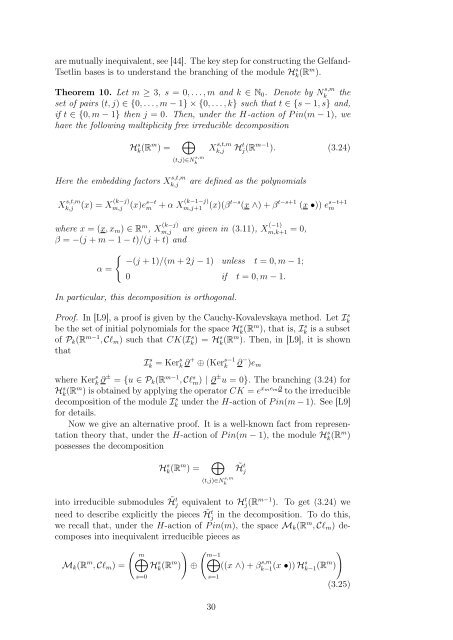Hypercomplex Analysis Selected Topics
Hypercomplex Analysis Selected Topics
Hypercomplex Analysis Selected Topics
You also want an ePaper? Increase the reach of your titles
YUMPU automatically turns print PDFs into web optimized ePapers that Google loves.
are mutually inequivalent, see [44]. The key step for constructing the Gelfand-<br />
Tsetlin bases is to understand the branching of the module H s k (Rm ).<br />
Theorem 10. Let m ≥ 3, s = 0, . . . , m and k ∈ N0. Denote by N s,m<br />
k the<br />
set of pairs (t, j) ∈ {0, . . . , m − 1} × {0, . . . , k} such that t ∈ {s − 1, s} and,<br />
if t ∈ {0, m − 1} then j = 0. Then, under the H-action of P in(m − 1), we<br />
have the following multiplicity free irreducible decomposition<br />
H s k(R m ) = <br />
Here the embedding factors X s,t,m<br />
k,j<br />
(t,j)∈N s,m<br />
k<br />
X s,t,m<br />
k,j Ht j(R m−1 ). (3.24)<br />
are defined as the polynomials<br />
X s,t,m<br />
k,j (x) = X (k−j)<br />
m,j (x)e s−t<br />
m + α X (k−1−j)<br />
m,j+1 (x)(β t−s (x ∧) + β t−s+1 (x •)) e s−t+1<br />
m<br />
where x = (x, xm) ∈ R m , X (k−j)<br />
m,j<br />
β = −(j + m − 1 − t)/(j + t) and<br />
α =<br />
are given in (3.11), X (−1)<br />
m,k+1 = 0,<br />
−(j + 1)/(m + 2j − 1) unless t = 0, m − 1;<br />
0 if t = 0, m − 1.<br />
In particular, this decomposition is orthogonal.<br />
Proof. In [L9], a proof is given by the Cauchy-Kovalevskaya method. Let Is k<br />
be the set of initial polynomials for the space Hs k (Rm ), that is, Is k is a subset<br />
of Pk(Rm−1 , Cℓm) such that CK(I s k ) = Hs k (Rm ). Then, in [L9], it is shown<br />
that<br />
I s k = Ker s k ∂ + ⊕ (Ker s−1<br />
k ∂ − )em<br />
where Ker s k ∂ ± = {u ∈ Pk(R m−1 , Cℓ s m) | ∂ ± u = 0}. The branching (3.24) for<br />
Hs k (Rm ) is obtained by applying the operator CK = exmem∂ to the irreducible<br />
decomposition of the module Is k under the H-action of P in(m − 1). See [L9]<br />
for details.<br />
Now we give an alternative proof. It is a well-known fact from representation<br />
theory that, under the H-action of P in(m − 1), the module Hs k (Rm )<br />
possesses the decomposition<br />
H s k(R m ) = <br />
(t,j)∈N s,m<br />
k<br />
into irreducible submodules ˜ H t j equivalent to H t j(R m−1 ). To get (3.24) we<br />
need to describe explicitly the pieces ˜ H t j in the decomposition. To do this,<br />
we recall that, under the H-action of P in(m), the space Mk(R m , Cℓm) decomposes<br />
into inequivalent irreducible pieces as<br />
Mk(R m <br />
m<br />
, Cℓm) = H s k(R m <br />
) ⊕<br />
s=0<br />
m−1<br />
<br />
s=1<br />
30<br />
˜H t j<br />
((x ∧) + β s,m<br />
k−1 (x •)) Hs k−1(R m )<br />
<br />
(3.25)

















